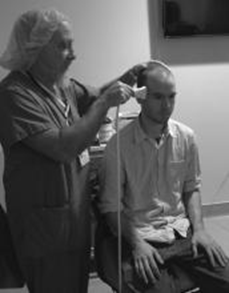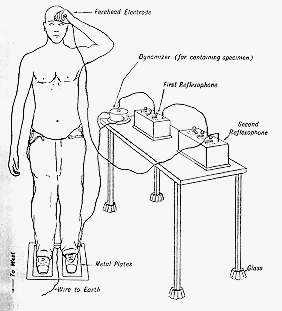Frequency of PSI
Originally published in the Australian Institute of Parapsychological Research News.
The AIPR News, Volume 13, Issue 1, March 2019.
www.aiprinc.org
Vladimir Dubaj
Perusing one of Colin Wilson’s older books [1], I came across material suggesting that Extra Sensory Perception (ESP) may be enhanced by high frequency oscillations of neural tissue, whether by electrical, magnetic or mechanical means. This idea is not necessarily new, but I am always interested in following up lines of evidence I’d not come across previously. There is some similarity between parapsychologists trying to find specific ‘frequencies’ associated with PSI conducive states and neuroscientists trying to find a binding frequency of consciousness. The binding frequency of consciousness is proposed to be a frequency of oscillation within the brain which may be responsible for turning the neural processes of the brain into the conscious processes of the mind. One such proposed binding frequency has been thalamocortical activity centred in the gamma frequency range, around 40 Hz [2]. In a similar way, parapsychologists have been probing the brain suggesting certain low frequencies such as alpha waves (~10 Hz) or theta waves (~4Hz) were somehow involved in PSI due to observed correlations with the phenomena [3]. However, contemporary lines of research into high frequency stimulation effects on conscious states may be lending credence to Wilson’s old line of evidence that PSI may be associated with frequencies of stimulation up in the megahertz to gigahertz range.

Dr. Stuart Hameroff applying ultrasound stimulation to a subject
(source: www.quantumconsciousness.org)
Example of an Emanometer setup
(source: www.americanartifacts.com)
You may be sceptical that such high frequencies have anything to do with workings of the mind, but in 2016 a brain damaged patient with minimal consciousness was essentially ‘awakened’ through ultrasound stimulation of the thalamus [4]. This type of ultrasound stimulation of the thalamus has been shown to shorten anaesthesia time in animal studies [5]. Doctor Hameroff of the “Penrose and Hameroff” theory of consciousness mediated via microtubules, has also been investigating the non-invasive ultrasound technique on states of consciousness [6]. This contemporary research suggests higher frequency stimulation 1 – 8 MHz may interact with biological tissue to modulate states of consciousness.
From the parapsychological perspective, revisiting the more obscure line of evidence in Colin Wilson’s book, the idea of high frequencies moderating consciousness was proposed in the 1970’s by Peter Maddock, whose appendix within Wilson’s book summarised the gist of argument. Based on two lines of evidence, Maddock formulated the idea of high frequency activity interacting with neural processes involved in PSI phenomena and resulting in information composed of elements of memory being activated and arising in one’s conscious mind [3].
The two lines of evidence include:
- A case reported to the parapsychology foundation involving electrical engineers working with high frequency equipment. They noticed on occasion of becoming telepathic.
- Boyd’s Emanometer: a homeopathic device used to diagnose medical conditions using an oscillatory circuit. The oscillatory circuit consisted of little more than a capacitor and an inductor forming a what is claimed to be a system capable of generating a harmonic resonance to the individual being tested. Based on Maddock’s estimation this frequency range could be tuneable between 100 MHz to 1 GHz.
With regard to the first line of evidence, little further information could be garnered. However, the second line of evidence involving Boyd’s emanometer can be traced all the way back to 1924 when a formal investigation was conducted into its claims; an investigation resulting in the now famous “Horder Report” presented to the Royal Society of Medicine in 1925 [7]. The report found that all the tests conducted by the committee were found to be highly significant, despite the complete lack of understanding of how the machine actually worked. In fact, some of the observations suggest that PSI may inadvertently have played a part in its operation. Maddock postulates a resonant frequency of between 100 MHz to 1 GHz used to generate PSI phenomena related to the emanometer. Similarly, Hameroff has used frequencies up to 8 MHz to alter states of consciousness based on his microtubule model of consciousness. What does all this point to? There appears to be an area of research into PSI which is waiting for the right researcher.
References:
1. Wilson, C. (1978). Mysteries: An investigation into the occult, the paranormal, and the supernatural. Granada Publishing.
2. Gold, I. (1999). Does 40-Hz oscillation play a role in visual consciousness? Consciousness and cognition, 8(2), 186–95.
3. Maddock, P. (1977). An electromagnetic method of enhancing the brain’s coupling with telephathic PSI. In Peter Maddock (Ed.), Parascience Proceedings (pp. 271–290). Parascience Centre, Sprytown, Lifton, Devon, PL16 OAY, England: Parascience Proceedings.
4. Monti, M. M., Schnakers, C., Korb, A. S., Bystritsky, A. & Vespa, P. M. (n.d.). Non-Invasive Ultrasonic Thalamic Stimulation in Disorders of Consciousness after Severe Brain Injury: A First-in-Man Report. Brain stimulation, 9(6), 940–941. doi:10.1016/j.brs.2016.07.008
5. Yoo, S.-S., Kim, H., Min, B.-K., Franck, E. & Park, S. (2011). Transcranial focused ultrasound to the thalamus alters anesthesia time in rats. Neuroreport, 22(15), 783–7. doi:10.1097/WNR.0b013e32834b2957
6. Hameroff, S. (2019). Quantum Consciousness. Retrieved April 2, 2019, from https://www.quantumconsciousness.org/content/transcranial-ultrasound-0
7. Horder, T. (1925). A preliminary communication concerning the “Electronic Reactions” of Abrams with special reference to the “Emanometer” technique of Boyd. John Bale, Sons & Danielsson, London.
